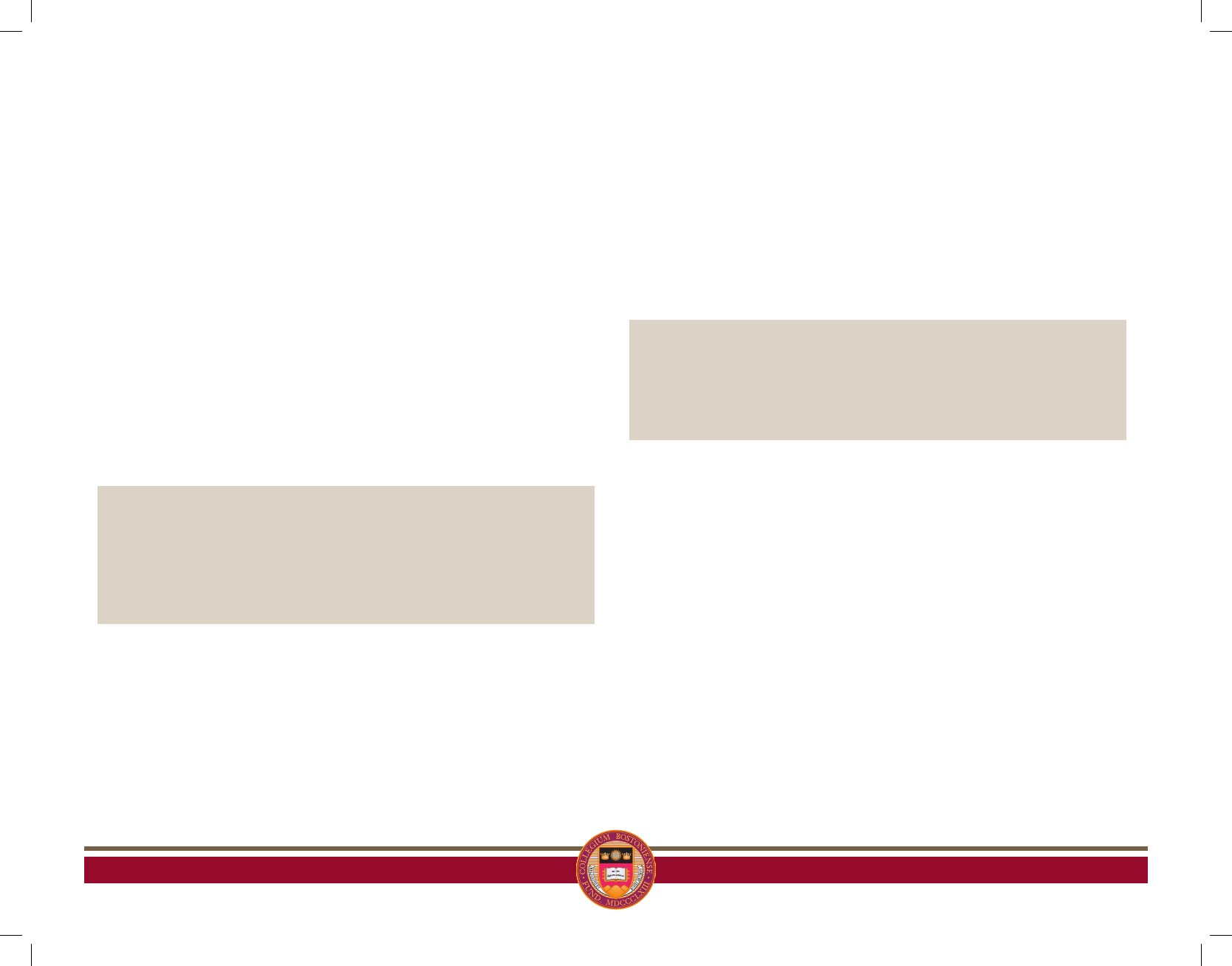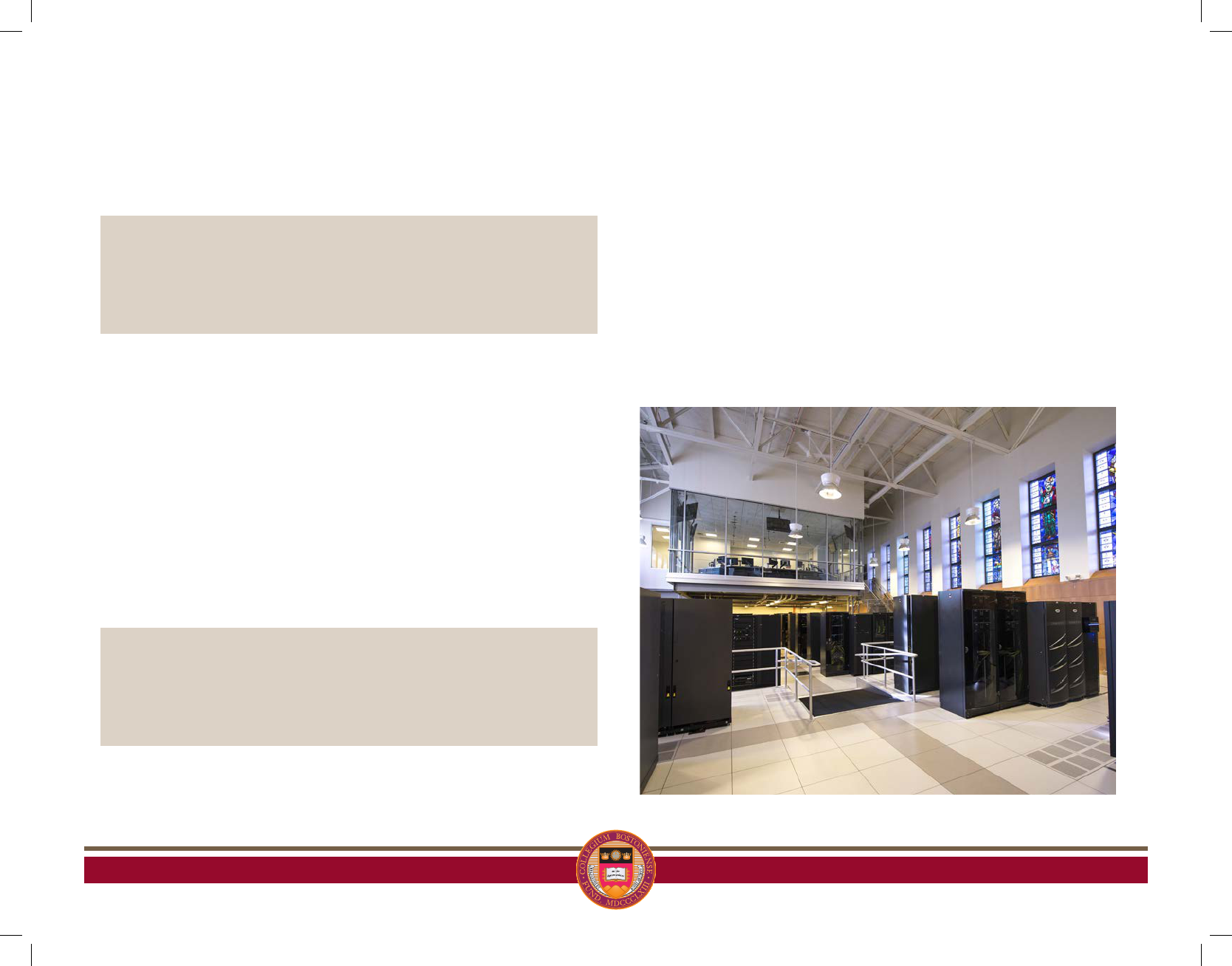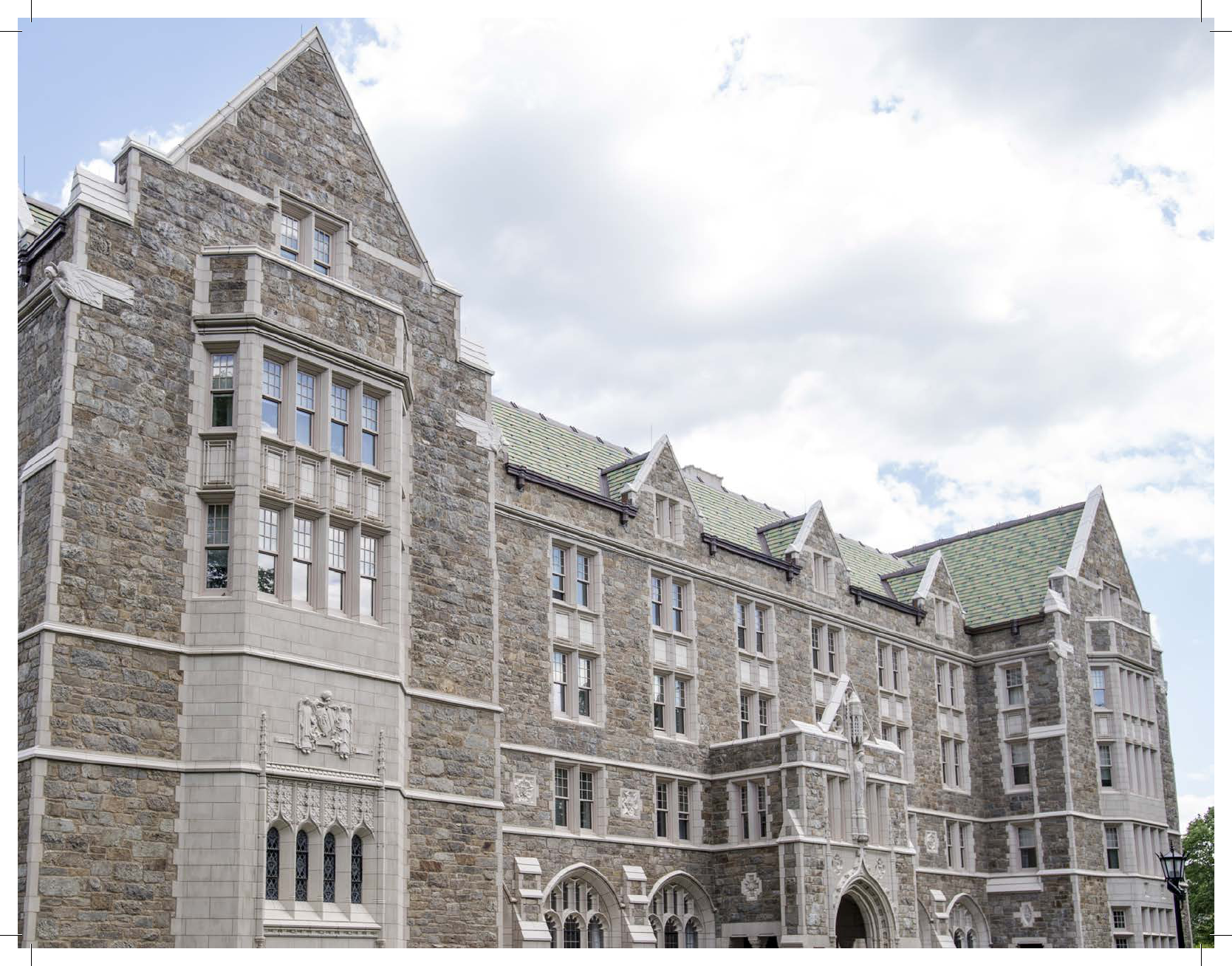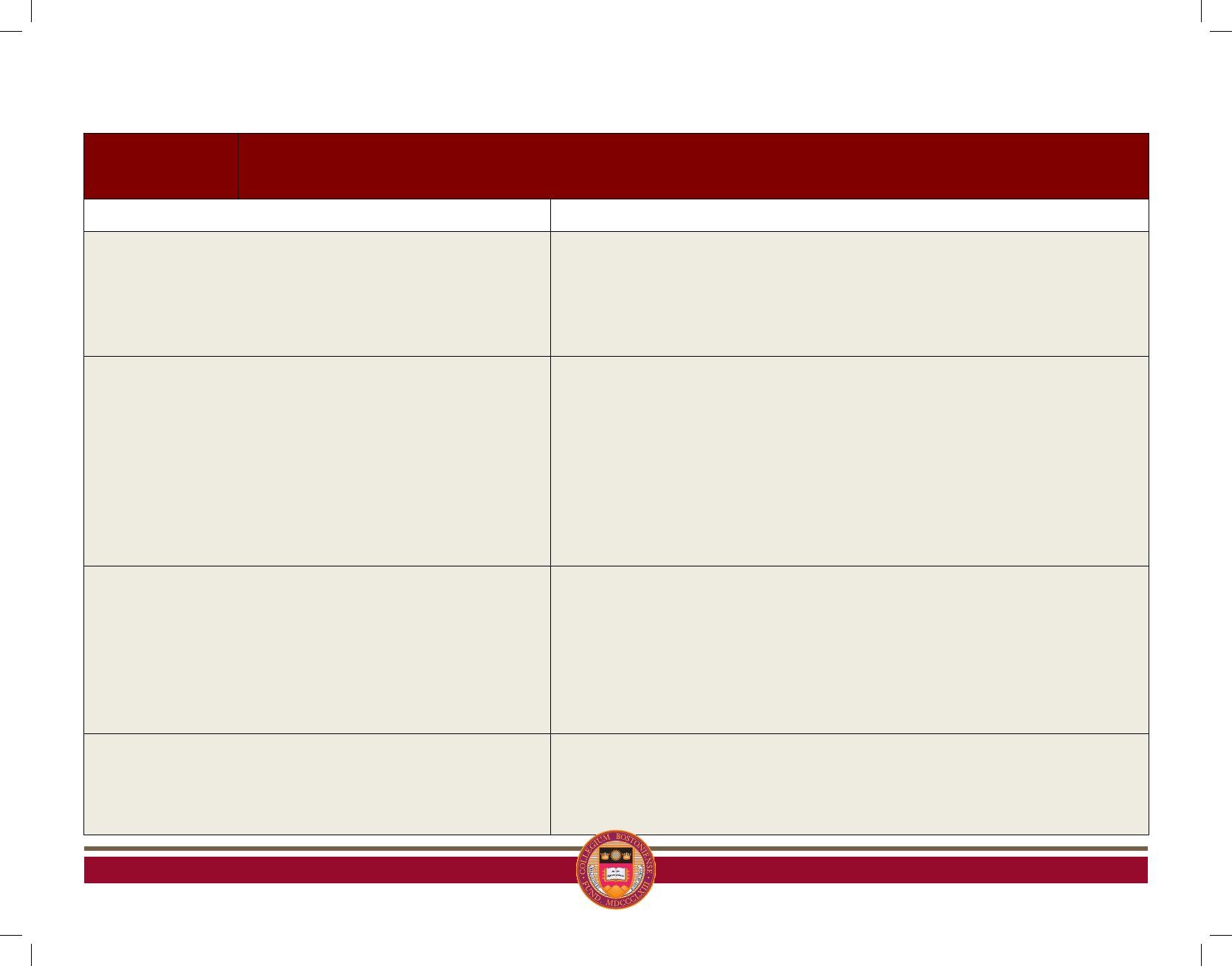
1
InformatIon technology
StrategIc Plan
boSton college ItS
verSIon 1.1, SPrIng 2015


Informaon Technology Strategic Plan
Boston College ITS
Version 1.1, Spring 2015

I am pleased to present this rst update to our strategic plan for
informaon technology at Boston College. Version 1.1 of our plan
demonstrates our commitment to ensuring that, in collaboraon
with our partners on campus, we connue to idenfy those
iniaves and strategies that are most important to the University.
Our goal of keeping our plan current helps ensure that our
resources connue to be aligned with the changing priories of the
University and in full support of the dynamic learning, research,
service, and student formaon iniaves at Boston College.
The process used to update our plan, while more streamlined than
our inial planning eorts, was carefully implemented under the
same guiding principles of inclusion, listening, and collaboraon
that successfully delivered version 1.0. We found that the growth
of the University’s use of technology connues to increase
the demand for advanced soluons and services. Several new
iniaves were idened and have been included in the plan.
Completed goals, objecves, and acon items were removed and
others consolidated to reect changes on the campus.
We remain commied, through our values of collaboraon,
service, connuous improvement, and innovaon, to the delivery
of quality soluons in support of the University’s mission.
On behalf of the enre ITS team of dedicated professionals, thank
you for your connued interest and support!
Leer from Vice President, Informaon Technology Services

1 Introducon
3 Vision, Mission, and Values
5 Key Strategic Iniaves
5 Learning and Teaching
7 Research
10 Customer Service
11 Administrave Applicaons
13 Security
15 Infrastructure
17 Moving Forward
18 Goals, Objecves, and Acon Items
26 Acknowledgments
Table of Contents

1
Informaon technology connues to be a key component in
how we support our faculty, students, researchers, and sta on
campus. Consequently, technology has become more pervasive
and plays an ever-increasing role in the daily lives of those in our
community both on and o campus. Technology not only supports
the demands of the academic environment, the needs of our
administraon, and the learning and quality of life of our students
but also the well-being and safety of our enre community.
The Informaon Technology Services (ITS) organizaon will
connue to ulize the established governance structures to
provide support and facilitate thoughul investment and
allocaon of resources to meet the needs of the community. Our
commitment to iniate an IT Strategic Plan and periodically review
it, as the needs of our community change and new technologies
become available, speaks to our ongoing focus on the expanded
use of technology and its importance in all areas of the University.
While working on this update to our plan, we have received
enthusiasc support demonstrated by the willingness of our
colleagues across the University to collaborate with ITS sta on
this eort.
The planning eorts were again focused on six strategic areas
of importance:
1. Learning and Teaching
2. Research
3. Customer Service
4. Administrave Applicaons
5. Security
6. Infrastructure
Teams of department representaves from across campus joined
with their ITS colleagues in a process that included a review of the
status of exisng goals, objecves, and acon items, and
concluded with a refreshed Strategic Plan. Prior to this Strategic
Plan review, interviews and conversaons with faculty, students,
and administrators across campus were also conducted and
provided valuable input to the process. As well, collaboraons
with exisng groups such as the Academic Technology Advisory
Board, Faculty Technology Commiee, and Data Security Ocers
provided insights into the changing needs and uses of technology
across the campus. These acvies and conversaons, in addion
to acon items from Administrave Program Reviews, have
informed and inuenced every aspect of our planning process.
Introducon

2
Buildingontheseefforts,atwodayplanningretreatprovidedthe
opportunitytofurtherenhancetheframeworkforthe
consolidationandalignmentofournewsetofgoals,objectives
andactionsitemswiththosecurrentlyintheplan.Asaresultof
thiscollaborativereviewprocess,theBostonCollegeInformation
TechnologyStrategicPlanwillcontinuetoserveasaroadmapfor
technologyattheUniversity.Itsgoalsandobjectivesareintended
toensurealignmentwiththeUniversityMissionandStrategic
Plan.Manyofourplan’sgoalsarelonglastingbutthesupporting
objectivesandactionitemswillcontinuetobeadaptedand
changedtoreflectchangestostrategicpriorities.Assuch,some
newobjectivesandactionitemshavebecomeapartofthis
update,butthedeliverablesidentifiedandincludedinthis
documentareacontinuationofeffortsidentifiedinVersion1.0of
ourplan.
InformationTechnologyServicesiscommittedtocontinuethis
levelofcollaboration,communication,andengagementaswe
regularlyrevisitourInformationTechnologyStrategicPlan.The
planwillcontinuetobeupdatedtoreflectchangestothecurrent
environmentorUniversitystrategicprioritiesaswellasthe
dynamicchangesintechnology.
Building on these eorts, a two-day planning retreat provided
the opportunity to further enhance the framework for the
consolidaon and alignment of our new set of goals, objecves,
and acons items with those currently in the plan. As a result
of this collaborave review process, the Boston College
Informaon Technology Strategic Plan will connue to serve
as a roadmap for technology at the University. Its goals and
objecves are intended to ensure alignment with the University
Mission and Strategic Plan. Many of our plan’s goals are long
lasng, but the supporng objecves and acon items will
connue to be adapted and changed to reect changes to
strategic priories. As such, some new objecves and acon
items have become a part of this update, but the deliverables
idened and included in this document are a connuaon of
eorts idened in Version 1.0 of our plan.
Informaon Technology Services is commied to connue this
level of collaboraon, communicaon, and engagement as we
regularly revisit our Informaon Technology Strategic Plan.
The plan will connue to be updated to reect changes to the
current environment or University strategic priories as well as
the dynamic changes in technology.

3
Informaon Technology Services Vision, Mission and Values
Vision Statement
Informaon Technology Services will be recognized as a high-
performance team providing technology excellence that advances
learning, teaching, research, and student formaon in alignment
with Boston College’s mission and goals.
Mission Statement
Informaon Technology Services provides secure, reliable and
integrated technology soluons in alignment with academic and
administrave goals, while delivering excellence in customer
service. In support of this mission, we will:
• Partner with the University community to understand the
informaon technology needs of faculty, sta and students.
• Provide leadership and planning for the eecve and strategic
use of emerging technologies.
• Demonstrate technical and operaonal excellence through a
commitment to professionalism and connuous improvement.
Boston College ITS Core Values
Our Core Values drive and guide us as we serve the University
community. As members of ITS, we are commied to:
• Collaboraon: We are dedicated to a construcve, team-
oriented environment, gathering varied perspecves, sharing
knowledge and building eecve partnerships with key
stakeholders.
• Connuous Improvement: We strive for operaonal
excellence through the on-going development of the sta and
the organizaon as a whole.
• Innovaon: We encourage creave and crical thinking in the
development of technology services and soluons.
• People: We listen to, respect, and care for faculty, sta,
students and one another, both professionally and personally.
• Service: We strive to provide excellent service by being
consistent, agile, reliable and accessible to all.
• Transparency: We leverage open communicaons and
thoughul business processes to be accountable in our
interacons and our work.

8

5
Learning and Teaching
Promong innovave and collaborave
opportunies for scholarship
The use of technology in support of learning and teaching
connues to evolve at Boston College. Informaon Technology
Services, in partnership with the Oce of the Provost, the
Center for Teaching Excellence (CTE), and other key stakeholders,
remains steadfast in its eorts to foster and sustain an academic
environment that promotes innovaon and scholarship. Through
the establishment of the CTE in 2014, Boston College connues
its focus on excellence in teaching by providing resources,
programming, and support for faculty and graduate students. The
CTE’s innovaon lab serves as a rapid prototyping environment
which will inform new classroom technology models and
standards. We look forward to collaborang with the CTE in
exploring new and innovave uses of technology in teaching even
as we connue to develop and support exisng pracces.
Physical and Virtual Learning Environments
Provisioning of learning models that align with the diverse
needs of our schools and also enhance and support the learning
experience.
In collaboraon with the Oce of the Provost, the CTE, and key
stakeholders across campus, we will work to idenfy the learning
and support models that best enhance the teaching and learning
needs of the community. Implementaon of the Canvas Learning
Management System provides a foundaon for the exploraon
of the appropriate mixture of blended and acve learning
designs. Moving to a more integrated physical and virtual learning
environment will greatly enhance the learning experience of our
students and extend its reach.
Student Informaon Systems
The integraon and combinaon of several student-related
applicaons (Enrollment Management, Student Accounts, etc.)
will provide technologies and support processes that can advance
BC’s technology posion and improve access and the ease of use
for our students.
In partnership with the Oce of the Provost, we will connue
with our implementaon of a modern Student Informaon
System (SIS) that provides next-generaon soware in support of
our core student processes. In addion to the Eagle Apps Student
modules, best-of-breed vendor soluons such as Degree Audit will
be implemented as part of the plan. This mixed approach will best
meet the full range of requirements for the new SIS at Boston
College. Our campus technology connues to change, and we will
ensure that our applicaon development and implementaon
eorts support the universal design framework that provides
guidelines for a barrier-free technology environment.


7
Research
Supporng excellence in academic inquiry
The value and success of research eorts across the campus
depend on the availability and reliability of excellent compung
resources. ITS connues to invest in the high-performance Linux
compung cluster in support of academic research pursuits.
The cluster is used by, but not limited to, Accounng, Biology,
Chemistry, Economics, Finance, Geology, Geophysics, Physics,
Psychology, Sociology, Instute for Scienc Research, Lynch
School of Educaon, Carroll School of Management, Theology,
and Graduate School of Social Work. Currently, users of the
Academic Research cluster have access to over 30 soware
packages. ITS will connue to provide focused support and
resources for researchers’ needs.
Enhance High-Performance Computaonal Resources
As research eorts on campus move toward a more data-centric
and computaonal model, the demands on our high-performance
Academic Research Cluster are projected to grow.
ITS will work to create and support resources for research
compung that foster community among researchers and provide
a vehicle to deliver compung resources and services in a shared
manner that is easily accessed by all faculty research groups. We
will perform quarterly usage analysis for the purpose of guiding
annual upgrades in performance and capacity of the Academic
Research cluster and web and database servers.
Research Community Service and Support
ITS Research Services provides a variety of services and stascal
support to researchers on campus.
We are commied to growing and developing a sta of research
compung professionals to support and assist researchers. ITS
Research Services sta will work with the Provost’s Oce and the
Vice Provost for Research to invesgate and provide the necessary
resources and capabilies to support the emerging scienc
and data needs of our researchers. We will provide stascal
programming support to assist in processing and analyzing grant
data, provide in-depth training in tools such as SAS, R, and Stata,
and assist with big data. ITS will connue to expand the Research
Services tutorials oered to include more topics in stascs,
qualitave methods, GIS, and other relevant areas.

8
Grant Management Support
A robust grant management applicaon is the foundaon for
service to research faculty and grant administrators.
ITS Research Services will work with the Vice Provost for
Research, faculty members, and the Oce of Sponsored Programs
to provide assistance to the Oce of Sponsored Programs. We
will oer support by providing direcon and guidance through the
requirements analysis, purchase, and implementaon of grant
management soware from pre-award through post-award.

9

10
Customer Service
Creang a culture of service excellence
The increased use of technology, in support of academic and
administrave needs on campus places a premium on service and
support. The ability to provide quality service requires connued
focus and organizaon. ITS is commied to ensuring that our
customer service iniave builds and sustains a culture of
service excellence. A framework based on the industry standard,
Informaon Technology Infrastructure Library (ITIL), will guide the
design of best pracces for informaon technology support and
service management. ITIL is a set of concepts and best pracces
for the management, delivery, and connuous improvement of
informaon technology services.
An Integrated, Customer-Centric, and
Intuive Experience
A support environment (physical and virtual) where members of
the BC community enjoy an experience that is customer-focused,
personalized, and intuive is a key iniave in our support plan.
In collaboraon with the Oce of the Provost, Center for Teaching
Excellence, and University Libraries, we will connue to improve
the physical spaces for service and the provisioning of technology
in support of pedagogy and research, greatly improving the
quality of support. We will also connue to enhance and deliver
a Catalog of Services which will provide an intuive, customer-
centric, self-service tool for all services, not just those of ITS.
Connuous Service Improvement
High-performing service organizaons benet from the existence
of a service culture that promotes connuous review and
improvement. ITS will work to create and connually improve a
culture of service and support within the organizaon.
ITS will develop and implement well-arculated service and
support protocols based on industry standards. We will review
exisng service and support procedures against frameworks
such as ITIL, dening specic plans for improvement and ongoing
review. We will also leverage the important partnerships with our
user community to ensure that their needs are guiding connuous
review and improvement. Through these personal connecons,
systemac data collecon, and analysis, we will connually
improve a framework for service delivery and support that best
meets the needs of the University. Addionally, we will focus on
developing a culture of service by conducng ongoing customer
service training programs for both support personnel and key
partners to maintain a consistent approach to service excellence.

11
Administrave Applicaons
Providing tools for organizaonal
eecveness and alignment
Administrave applicaons impact all members of the Boston
College community. Key to the successful operaons of the
University, these applicaons support business processes,
provide tools that support analysis and decision making,
and ensure compliance with regulatory requirements. ITS, in
partnership with the user community, will connue to enhance
administrave applicaons to improve funconality, accessibility,
and service delivery.
Business Intelligence and Enterprise Reporng
Decision making at all levels across the University requires access
to informaon. An enterprise data repository that consolidates
data from mulple authencated sources is a vital component in
support of decision making and related informaon needs such as
reporng and analysis.
In collaboraon with Instuonal Research, University
Advancement, Finance, as well as other key administrave areas,
ITS will develop a University Business Intelligence Strategy. We will
connue to design and develop the data architecture to provide
informaon that is consistent, accurate, and secure. We will also
develop and implement educaon and communicaon plans
that eecvely communicate our enterprise reporng soluons
and best pracces to improve the awareness and adopon of
enterprise tools and reporng processes. In addion, ITS will
review exisng reporng frameworks and tools (strategic and
operaonal) and clearly dene operaonal reporng standards.
We will also invesgate and recommend alternave frameworks
for the management of supplemental department data.
Evolve ITS Applicaon Environment
Applicaon development and delivery has become more
complex and the demand for applicaons to be available on all
devices presents a challenge for ITS. The connued growth of
SaaS (Soware as a Service) provides new opportunies and
challenges.
ITS will connue to expand the use of SaaS opons, where
appropriate, under a University applicaons architecture
framework. ITS will dene and document SaaS guidelines and
the architecture framework. We will review industry standards
and best pracces for applicaon development and delivery.
We will develop an applicaon development architecture
roadmap based on industry standards and best pracces. We
will connue to support accessibility requirements for tools
and technologies provided to the Boston College community
and develop a plan for connuous engagement with
departments on accessibility iniaves.

12
Collaborave Relaonships
Collaboraon with the University community is central to our
vision and mission and key to understanding the informaon
technology needs of faculty, researchers, sta, and students.
ITS will connue to idenfy and foster opportunies for
synergisc and collaborave relaonships around technology
both internally among the University’s administrave units and
externally among regional instuons. We will build on the
success of the Technology Forum to explore and share ideas
on technology soluons. We will improve our capability to
successfully educate, implement, and train the community on
new innovaons and technologies.

13
Security
Managing risk with people, process,
and technology
Informaon Technology Services connues its commitment to
the BC community that the University’s informaon resources
are protected using industry standards and best pracces. Our
security iniaves focus on ensuring the condenality and
integrity of these resources while increasing the level of security
awareness and educaon of our user community. We connue
to enhance our data and network infrastructure and update our
informaon security policies as needed.
Security Infrastructure
The University connues to face substanal security-related
challenges including compliance, and nancial and reputaonal
risks if appropriate procedures are not adhered to on a
connuous basis. Arculaon and adopon of the University
security architecture will ensure a common understanding of
security iniaves and procedures.
ITS will connue to develop informaon security infrastructure
and management pracces using industry standards (ISO27002)
in support of the specic needs of the University. We will
connue to build on exisng frameworks for security educaon
and awareness as a means of minimizing the associated risks to
the University community. We will document and communicate
the security architecture roadmap to facilitate and support the
adopon and implementaon of technologies and processes
across the campus in a secure manner. We will develop ITS
security checklists that outline best pracces and allow user-
friendly self-cercaon as a means of ongoing risk migaon.
Data Security
Data connues to be one of our strategic assets. Our
commitment to data security and integrity is strongly
supported by University senior management. The protecon or
stewardship of data is the responsibility of all members of the
Boston College community.
ITS will work to strengthen the overall data security posture by
enhancing Boston College business pracces so that consistent
data security pracces are in place throughout the community.
We will design and implement an ongoing data security
awareness campaign for all levels of the University community.
In collaboraon with other key groups (e.g., Data Security
Ocers), we will connue to focus on mandatory data security
training while introducing addional content as appropriate.
ITS will work to ensure compliance with the University Data
Security Policy via training and awareness. We will create
environments that encourage the safe storage of data, including
automang safe storage where appropriate. In addion, we
will also rene the implementaon of the governance model
outlined in the University Data Security Policy to improve data
security at Boston College and work to classify University data
in accordance with the University Data Security Policy.

14
Security Educaon and Awareness
ITS has made signicant progress in raising the awareness
of members of the Boston College community regarding
security and the protecon of informaon assets. We are
commied to connuing this educaon and awareness and
will connue our eorts to minimize the associated risks to
the University community.
We will connue to implement our security awareness and
educaon programs across the campus. These programs will
address current and potenal risks, and compliance issues, and
be a collaborave eort with our partners across the campus.
These programs will reect external research and incorporate
industry best pracces.

15
Infrastructure
Ensuring current and future compung
requirements are realized
As the needs for technology on campus connue to change, our
ability to provide a technology infrastructure that is reliable,
scalable, and exible is of paramount importance. An adaptable
and agile infrastructure upon which Informaon Technology
can deliver services to the Boston College community will
ensure our ability to meet growing user needs and support
University goals. Our infrastructure iniaves will posion us
for greater adaptability and capacity as we incorporate many of
the transformaonal technologies being introduced on campus.
ITS selects projects for investment that support the connuous
improvement of our infrastructure while ancipang the future
technology needs of the Boston College community.
Identy Access Management
The need for users to securely and seamlessly access data or
systems across mulple domains/locaons is driving our eort to
implement a modern Identy Access Management System.
We will connue our eorts to implement and leverage federated
identy services to enable and support secure collaboraon with
colleagues at other instuons and improve access to applicaons
and systems for members of the Boston College community.
Following the Identy and Access Management (IAM) strategy
and architecture developed for Boston College, we will adopt and
implement iniaves including Mul Factor Authencaon (MFA),
Single Sign On (SSO), and Federated Identy Management (FIM).
We will implement a modern person data management system,
rene our access controls to provide the appropriate level of
granularity, and provide access to new constuents.
Mobile Infrastructure
The demand for locaon- and device-independent access to
applicaons and informaon by members of the Boston College
community and its aliates has driven our eorts to deliver
services to meet these needs.
To support this, ITS will work to evaluate the mobility needs of
the community and dene and develop a mobile access strategy
and architecture balancing security and ease of access to Boston
College services.
Virtualizaon and Cloud-Based Technologies
Virtualizaon and cloud-based compung connue to inuence
and shape our ability to improve service delivery to our users.
We will connue to achieve eciencies in providing IT services by
leveraging virtualizaon and cloud-based technologies where and
when appropriate. We will explore the use of IaaS (Infrastructure
as a Service) opons, where appropriate and cost-eecve, within
the appropriate University IT frameworks. We will connue to
build out our internal cloud pilot to evaluate the viability of such
an opon, and connue to expand the use of virtual servers in the
Data Center in support of University iniaves as appropriate.

16
Capacity Planning and Connuous Improvement
The growth and expansion of University services and
applicaons require an ongoing commitment to investment
in our infrastructure. A thoughul review of, and measured
planning eort for, infrastructure investments will ensure a
reliable and scalable technology infrastructure.
ITS will implement a storage study to maintain and grow the
disk storage infrastructure to address the needs of the BC
community for data storage. We will also monitor the need
for high-performance compung as it relates to big data. We
will connue the work to improve the wireless infrastructure,
including bandwidth and coverage, and expand our coverage
of outdoor spaces. We will develop a roadmap and plan for
transion to new internet protocol standards (IPv6) and
integraon with IPv4. ITS will include a focus on sustainability
while planning for increased capacity and new services.
Enterprise Infrastructure Applicaons
Enterprise applicaons are key components of infrastructure
services provided to the Boston College community.
Applicaons such as email, MyFiles, bc.edu, and the Agora
portal provide addional support for core business funcons
and require connued review and modernizaon.
ITS will connue to provide enterprise applicaons through
an array of collaboraon tools that support the University’s
business and informaon needs. The migraon of students,
faculty, and sta to Gmail and our work to replace MyFiles
(web storage) with more modern tools are examples of the
way we have leveraged on-site and Soware as a Service (SaaS)
to best meet the needs of our community. We are analyzing
our web capabilies as part of our evaluaon and redesign
of the University website (bc.edu) and review the skills and
technologies needed to sustain this core University service.

17
Moving Forward
This plan presents the updated
priories and iniaves for informaon
technology at Boston College. The work
presented here includes some new
iniaves and ongoing eorts idened
in Version 1.0 of our plan.
We look forward to working with our
colleagues across the campus to bring
this plan and its goals to fruion.
We will connue to update this plan
as needed to reect any changes to
our current environment and any new
University priories. We will connue
to communicate regularly on our
progress.
Please visit our website at www.bc.edu/
its-plan for more informaon or contact
Denis Walsh, Director, ITS Planning and
Porolio Governance, at denis.walsh@
bc.edu.

18
Goals,Objectives,andActionItems
LearningandTeaching
GOALI
Createandsustainanacademicenvironmentthatpromotesinnovationandscholarship,andthroughcollaboration
encouragestheexplorationandadoptionofnewteachingtools.
OBJECTIVES ACTIONITEMS
1.WorkwiththeOfficeoftheProvost,theCenterfor
TeachingExcellence,andkeyacademicstakeholdersto
identifystrategiesforenrichingfacultyandstudent
scholarshipandteachingusingemergingtechnologies.
• Developaroadmaptoguidefacultyandstudentadoptionofinnovative
technology.
• Developsupportmodelsthatencourageactiveandreflectivelearning.
2.WorkwiththeOfficeoftheProvost,theCenterfor
TeachingExcellence,andkeyacademicstakeholdersto
identifystrategiesforimplementingonlineinitiativesto
enhanceandsupportthelearningexperience.
• Researchvariousmodelsofonlinedeliverythatalignwithschool,
department,andprogramgoals.
• Implementaframeworkforonlinecoursedeliverythatincludesthe
appropriatetechnology,support,andresources.
• InvestigateanddeterminetheneedforcompetencybasedmodelsatBoston
College.
GOALII
ProvidetechnologiesandprocessesthatfacilitateBC’spositionattheforefrontofteachingtechnologyandenhancethe
learningexperienceofstudents.
OBJECTIVES
ACTIONITEMS
1.Continuetoenhanceaccessibilityofcoursematerialsand
learningenvironmentsinsupportoftheUniversity’sgoalofa
barrierfreeenvironment.
•
Investigateopportunitiestoprovideclosedcaptioningfornewmediaand
publicmediaalreadyproduced.
• Developaplanforthecontinuousengagementoffacultyandstudentson
accessibilityinitiatives.
2.ImplementamodernStudentInformationSystemthat
providesnextgenerationsoftwaretosupportandimprove
ourcorestudentprocesses.
•
AdoptLearningToolsInteroperability(LTI)asthestandardmethodof
integratingapplicationswithinourLearningManagementSystem.
• DevelopagovernanceprocessandstandardsforaddingnewLTIs.

19
Research
GOALI
ProvideservicesandtechnologiesthatsupporttheUniversity’sresearchcommunity.
OBJECTIVES ACTIONITEMS
1.WorkwiththeOfficeoftheProvostandtheViceProvost
forResearchtoinvestigateandimplementrequiredresources
andcapabilitiestosupportemergingscientificanddataneeds.
•
ExpandResearchServicestutorialstoincludemoreofferingsinstatistics,
qualitativemethods,GeographicInformationSystems(GIS),andothertopics.
• Providestatisticalsupportforgrants.
• Providestatisticalprogrammingsupporttoassistinprocessingandanalyzing
grantdata,toprovideindepthtrainingintoolssuchasSAS,R,andStata,
andtoassistwithbigdatainitiatives.
• ProvideGISsupportfortheHumanitiesandSocialWork.
• SupportUniversityinitiativesonbigdataandserveanactiveroleasBoston
Collegeworkstoadvanceitsintegratedsciencesprograms.
2.Facilitatethebusinessprocessesofgrantandpurchase
management.
•
AssisttheOfficeofSponsoredProgramsbyprovidingtherequired
applicationsforgrantmanagementfrompreawardthroughpostaward.
Thissupportincludestheselection,purchase,andimplementationof
supportingsoftware.
GOALII
Createandsupportresourcesforresearchcomputingthatfostercommunityamongresearchersandprovideavehicleto
deliversharedcomputingresourcesandservicesinamannerthatiseasilyaccessedbyfacultyresearchgroups.
OBJECTIVES
ACTIONITEMS
1.Continuetoenhancehighperformancecomputational
resourcestosupporttheevolvingrequirementsofthe
researchcommunity.
• Performquarterlyusageanalysisforthepurposeofexecutingannual
upgradesinperformanceandcapacityoftheResearchComputingcluster.
2.Continuetoprovideanddevelopastaffofresearch
computingprofessionalstosupportandassistresearchers.
•
Continuetoincreaseourcapabilitiesinscientificcomputingtechnologies,
includingparallelcomputing,andsoftwaretoolssuchasMATLABand
researchmethodssuchasNetworkAnalysis,MultilevelModeling,Mixed
Methods,andBiostatistics.

20
CustomerService
GOALI
WorkingwithinITSandwithourBostonCollegepartners,transformtheexistingsupportmodeltoonethatismore
integrated,customercentric,andintuitive.
OBJECTIVES ACTIONITEMS
1.Furtherdevelopandenhancethephysicalandvirtual
customerexperienceformembersoftheBCcommunityin
ordertocontinuouslyimprovetheiruseoftechnology.
• Securebenchmarkingactivitieswithkeypartnersinhighereducationaswell
asotherindustryverticalssuchashospitalityandhealthcare.
• ContinuedevelopingtheServiceCatalogtoprovideanintuitive,customer
centricselfservicetoolforalltechnologyservices.
• ContinueworkwiththeOfficeoftheProvost,CTE(CenterforTeaching
Excellence),andUniversityLibrariestocreatephysicalspacesforresearch,
support,andtheprovisioningoftechnologyinsupportofpedagogy.
GOALII
CreateandcontinuallyimproveacultureofserviceandsupportwithintheITSorganization.
OBJECTIVES
ACTIONITEMS
1.Developandimplementawellarticulatedserviceand
supportmodelbasedonindustrystandards.
• Reviewexistingserviceandsupportproceduresagainsttheindustrystandard
frameworkssuchasInformationTechnologyInfrastructureLibrary(ITIL)and
TotalQualityManagement(TQM).Performgapanalysisanddefinespecific
plansforimprovement.
• DevelopastrategyformanagingthemanyrelationshipsbetweenITSandits
userbaseacrosstheBostonCollegecommunity.
2.CreatecollaborationteamswithITSandBCpartnersforthe
purposeofgeneratingactionableimprovementsinservice.
•
WithintheareasofCustomerRelationshipManagement,Customer
IntelligenceandAnalytics,ContinualServiceImprovement,andResearchand
Development,developaframeworkforserviceimprovementthatbestserves
theneedsoftheUniversity.
3.Offerregularinternaltrainingopportunitiesforthepurpose
ofcreatingaconsistentapproachtoserviceexcellence.
•
Createongoingcustomerservicetrainingprogramsforbothsupport
personnelandkeyITSpartners.

21
AdministrativeApplications
GOALI
DevelopandimplementarobuststrategyandframeworktoensurethatBostonCollegeadministrativedataisreliableand
supportiveofimprovedadministrativeoperationscampuswide.
OBJECTIVES ACTIONITEMS
1.DevelopaUniversityBusinessIntelligenceStrategy(data,
reporting,andanalytics)withappropriatesecuritystandards
incollaborationwithInstitutionalResearch,University
Advancement,andFinanceaswellasotherkeyadministrative
areas.
•
Reviewexistingreportingframeworksandtools(strategicandoperational)
anddefineoperationalreportingstandards.
• Developandimplementeducationandcommunicationplansthatsupport
enterprisereporting.
• Investigateandrecommendalternativeframeworksformanaging
supplementaldepartmentaldata.
GOALII
EvolveBostonCollege’sadministrativeapplicationsdevelopmentenvironmenttoleveragecommonindustrystandardsand
practicestoprovidethebestsolutionstomeetUniversityneeds.
OBJECTIVES
ACTIONITEMS
1.ExpandtheuseofSaaS(SoftwareasaService)options,
whenappropriate,undertheapplicableUniversityIT
frameworks.
• DevelopsystemsandguidelinestoprovideongoingUniversitywideguidance
forSaaS.
2.Identify,define,anddevelopUniversityapplication
architectureframework.
•
Reviewcurrentinusetechnologies.
• Identifypossibleconsolidationofapplicationtools(e.g.,source
management,productioncontrol).
• Createstandardsaroundauniformapplicationdevelopmenttoolset.
3.Continuetosupportaccessibilityrequirementsfortoolsand
technologiesusedbytheBostonCollegecommunity.
•
Investigateopportunitiestoenhanceaccessibilityofexistingandnew
applications.
• Developaplanforcontinuousengagementwithdepartmentsonaccessibility
initiatives.

22
AdministrativeApplications
GOALIII
Identifyandfosteropportunitiesforsynergisticandcollaborativerelationshipsaroundapplicationstechnology,both
internallyamongtheUniversity’sadministrativeunitsandexternallyamongregionalinstitutions.
OBJECTIVES
ACTIONITEMS
1.ImproveITScapabilitytosuccessfullyeducate,implement,
andtrainthecommunityonnewinnovationsand
technologies.
• WorkwithITSchieftechnologisttodeveloproadmapsforadoptionof
technicalsolutionsandrequiredstaffdevelopment.
2.FacilitatediscussionsaroundaCustomerRelationship
Management(CRM)strategytoaddresscurrentandfuture
Universityneeds.
• Createaworkgrouptodeveloparoadmap/visionforCRMatBostonCollege.

Security
GOALI
AdvanceBostonCollege’sinformationsecurityinfrastructureandmanagementpracticesusingindustrystandards
(ISO27002)insupportofthespecificneedsoftheUniversity.
OBJECTIVES ACTIONITEMS
1.PositionBostonCollegeasaleaderinsecurityeducation
andawarenessasameansofminimizingtheassociatedrisks
totheUniversitycommunity.
•
Designandimplementongoingdatasecurityawarenesscampaignsforall
levelsoftheUniversitycommunitythat:
• addresscurrentandpotentialrisksandcomplianceissues
• reflectoutsideresearchandbestpractices
• areinformedbycommunityinputandfeedback
2.Strengthentheoveralldatasecurityposturebyenhancing
BostonCollegebusinesspracticestoensureconsistentdata
securitypracticesareinplacethroughoutthecommunity.
• Createenvironmentsthatencouragesafestorageofdata,including
automatingsafestoragewhereappropriate.
• Inconjunctionwiththedataclassification(seeSecurityGoalI,Objective3)and
IAM(seeInfrastructureGoalI,Objective1)actionitems,reviewuserrolesto
determineifadditionaloversightandpreventioncanbeprovidedforthose
withaccesstosensitivedata.
• DevelopITSsecuritycheckliststhatoutlinebestpracticesandallowself
certificationasameansofongoingriskmitigation.
3.Refinetheimplementationofthegovernancemodel
outlinedintheUniversityDataSecurityPolicytoimprovedata
securityatBostonCollege.
•
ClassifyUniversitydatainaccordancewiththeUniversityDataSecurityPolicy.
• Createuserfriendlyprocessesandtoolsforgeneraldataclassification
purposes.
• ReassesstherolesandcompliancerequirementsdefinedintheUniversity
DataSecurityPolicyandproposepracticalrecommendationsforthe
operatingenvironment.
• EffectivelycommunicatetherefinedUniversityDataSecurityPolicy.
4.Providetechnologiesandprocessesthatfacilitateadoption
ofsecurityinitiatives.
•
Provideacleararticulationofthesecurityarchitectureanddirectionto
ensureacommonunderstandingandapplicationofUniversitysecurity
initiatives.
• Documentandcommunicatethesecurityarchitectureroadmap.
23

Infrastructure
GOALI
TransformBostonCollege'sinfrastructureandapplicationservicestobettermeetuserneedsandsupportUniversitygoals
throughidentification,testing,andadoptionofnewinformationtechnologythatwillsupporttheUniversity’smission.
OBJECTIVES ACTIONITEMS
1.Implementaflexible,modernIdentityAccessManagement
SystemthatsupportscoreUniversityprocesses.
•
ImplementamodernAccessManagementsystemthatincludes:
• multifactorauthentication
• singlesignon
• federatedidentitymanagement
• updatedgroupsmanagement
• accesstonewpopulations
• accesscontrolstoprovidetheappropriatelevelofgranularity
• amodernpersondatamanagementsystem
• privilegedaccountmanagementsystem
2.AchieveefficienciesinprovidingITservicesleveraging
virtualizationandcloudbasedtechnologieswhereandwhen
appropriate.
• Exploreenhancementsandnewtechnologiesforapplicationdeliveryto
addressneedsforbothenterpriseandspecializedapplications.
• Introduceaninternalcloud.
3.EmpowerandsupporttheBCcommunityandaffiliatesfor
locationanddeviceindependentaccesstoUniversityservices
withaservicetomeettheseneeds.
• EvaluatethemobilityneedsoftheBCcommunity.
• DefineanddevelopamobileaccessstrategyandarchitectureforBCservices
thatincludessecurityandeaseofaccess.
4.Provideefficient,effective,andsecureaccesstoenterprise
informationtoensurequalityauthoritativeinformation
management.
•
Provideandprovisionamasterdatamanagementsolutioncomprisedof:
• anenterprisedatawarehouseandanoperationaldatastore
• datamartsandcubes(foranalytics)
• enterprisereportingsystem
• EnhancetheBCdatagovernancemodelandprocessforefficientand
effectiveaccesstoenterpriseinformation.
5.ExploretheuseofIaaS(InfrastructureasaService)options,
whereappropriateandcosteffective,withintheappropriate
UniversityITframeworks.
• Exploresolutionsincludingsoftwaredefinednetworksandnextgeneration
backupandrecoverystrategiesconsideringsecurity,capability,automation,
monitoring,andcost.
24

25
Infrastructure
GOALII
Provideenterpriseresourcesandprocessesthatfostercontinuousimprovementandorganizationaleffectiveness.
OBJECTIVES ACTIONITEMS
1.Developeffectivearchitecturalframeworksthatreflect
futurerequirementsandprovideameansforeffective
managementinidentifyingandselectingnewinformation
technology.
•
Developaframeworkandmethodologyfortheidentificationofinnovative
andnewtechnologiesandsolutionsthatimproveITSservicedeliveryand
efficiency.
• AnalyzecommonITSservicesandcreatetechnologytemplatestofacilitate
provisioning,configuration,andaccesscontrol.
• Develop,maintain,andcommunicatetheUniversityarchitecturesand
transitionplan.
2.Continuetoimproveenterprisebestpracticesfor
governance,capitalplanning,riskmanagement,andITS
projectportfoliomanagementthatareparticipativeand
transparent.
•
Evaluateexistingprocessestoensurethattheyresultinenhanced
productivity,efficiency,andagility.
• Exploremethodstoimprovetwowaycommunication,opendiscussion,and
thecultivation/exchangeofideas.
• PromoteandfosterskillsinITSthatallowthestafftokeeppacewithrapid
technologicaladvanceswhilecontinuingtoshifttheculturefrom“maintain
andoperate”to“innovate,operate,andmaintain.”
3.Developacapacityplanningandcontinuousimprovement
practice,includingsustainability,forservers,storage,and
networks.
•
Maintainandenhancethestorageinfrastructure.
• DeveloparoadmapandplanfortransitiontoIPv6andintegrationwithIPv4.
• Monitorneedforhighperformancecomputingandstorageasitrelatesto
bigdata.

26
Acknowledgments
A successful strategic planning process cannot be done in a
vacuum. This updated strategic planning document represents
the eorts of many members of the Boston College community.
The update process engaged team members in various ways and
culminated in a two-day planning retreat. The engagement and
support of all those involved not only demonstrates the level of
commitment to the task but also highlights the partnership that
exists between ITS and the enre Boston College community.
Guiding this update process from its inial stages to the
compleon of this updated version of the IT Strategic Plan
has been a most rewarding challenge and experience. The
process connues to have a transformaonal impact on the ITS
organizaon and reinforces our commitment to partnership and
collaboraon.
We would like to express our thanks to everyone who helped us
along the way. In parcular we would like to thank:
The academic groups who provided support and assistance:
The Academic Technology Advisory Board (ATAB), Faculty Tech
Contacts (FTC), University Research Council, the Center for
Teaching Excellence, and Instruconal Design and eTeaching
Services (IDeS).
Kelli Armstrong and Mike Pimental from IRPA.
Deans and Vice Presidents for their connued support and access
to resources.
Our hard-working Team Leads and Team Members.
Patricia Todus, Principle, TLC Resources Corp.
ITS Media Technology Services and the Oce of Markeng
Communicaons for photography services.

Boston College Information Technology Services
140 Commonwealth Avenue
Chestnut Hill, Massachusetts 02467
Phone: (617) 552–6060
www.bc.edu/its
© 2015 Boston College Information Technology Services. All rights reserved.
This publication is available online at:
www.bc.edu/its/strategicplan
No portion of this document may be excerpted, copied, or reproduced in any
manner without the express written consent of Boston College.
